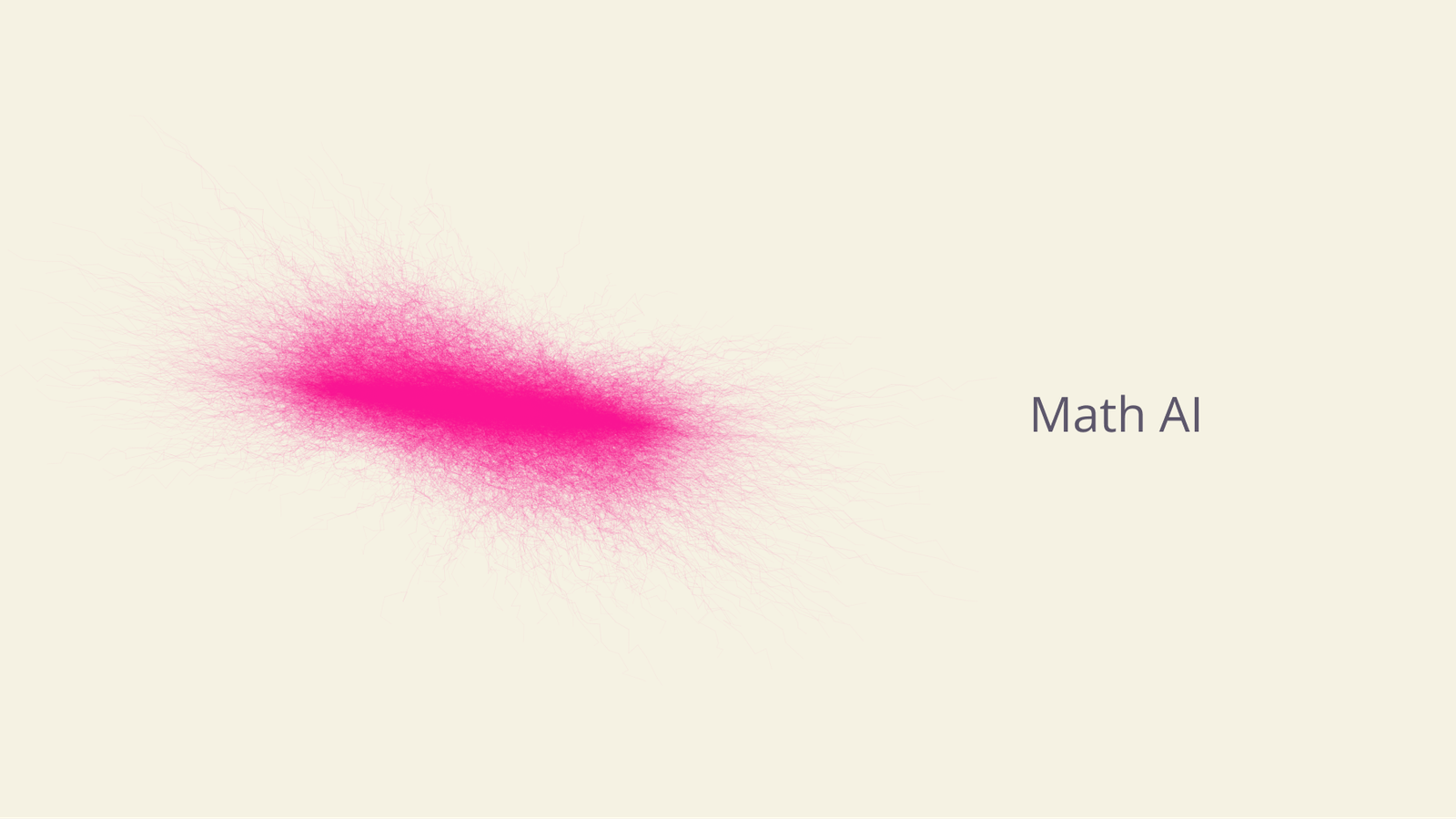MJ Lindeman, PhD, Community Partner
Jun 6, 2025

Table of contents
- The evolution of mathematical problem-solving
- Advanced capabilities of modern math AI
- Practical applications in education
- Mathematical foundations for AI development
- Quadratic's approach to math problem solving
- Building mathematical intuition through AI
- Ethical considerations and best practices
- The future of mathematical education
- Preparing for an AI-integrated mathematical future
- Conclusion
Mathematics has always been a fundamental skill that challenges students and professionals alike. From basic arithmetic to complex calculus problems, mathematical problem-solving requires not just computational ability but also a deep understanding of concepts, patterns, and relationships. Today, math AI is revolutionizing how we approach these challenges, transforming mathematical education and problem-solving from a solitary struggle into an interactive, guided learning experience.
The emergence of sophisticated AI math solver technologies represents more than just computational convenience. These tools are reshaping mathematical education by providing instant feedback, step-by-step explanations, and visual representations that help learners understand not just the answer, but the reasoning behind it. Modern AI for math goes beyond simple calculation to offer conceptual insights that were previously available only through one-on-one tutoring with expert mathematicians.
This transformation becomes particularly powerful when artificial intelligence combines with interactive computational environments. Instead of merely providing answers, the best AI for math creates learning experiences that engage multiple cognitive pathways through visualization, experimentation, and guided discovery. As demonstrated in this post, students can now upload images of complex problems and receive not just solutions, but complete analytical workflows that demonstrate mathematical thinking in action and in Python code.
Calculus is often regarded as mysterious and difficult to learn. However, ease of learning depends on the ability of the teacher to explain the conceptual models, which are the meanings of the symbols. For example, math teachers such as John Zimmerman, who does the TabletClass Math videos on YouTube, provide easy but accurate explanations. Watching Zimmerman’s videos while doing the problems in Quadratic AI makes fundamental calculus easy to learn.
The evolution of mathematical problem-solving
Traditional mathematical education relied heavily on memorization of formulas, repetitive practice, and limited feedback mechanisms. Students often struggled with complex problems not because they lacked mathematical ability, but because they could not visualize the concepts or understand the logical progression from problem statement to solution. The introduction of math-solving AI addresses these fundamental challenges by providing immediate, personalized guidance that adapts to individual learning styles and needs.
Modern AI math helper systems excel at breaking down complex problems into manageable components. Rather than presenting students with overwhelming multi-step procedures, these tools guide learners through each phase of problem-solving. This approach proves particularly valuable for advanced topics like calculus, where conceptual understanding often matters more than computational speed.
The integration of artificial intelligence with mathematical problem-solving also addresses the isolation that many students experience when struggling with difficult concepts. Using AI for math problems provides patient, non-judgmental assistance that encourages experimentation and learning from mistakes. Students can explore different approaches, test hypotheses, and develop deeper mathematical intuition without fear of embarrassment or time pressure.
Advanced capabilities of modern math AI
Contemporary math homework AI systems demonstrate remarkable sophistication in their ability to interpret, analyze, and solve complex mathematical problems. These systems can process handwritten equations, recognize mathematical notation from images, and even understand context clues that help determine the most appropriate solution approach. Popular platforms like Julius and Julius AI alternatives demonstrate how specialized AI systems can focus on particular mathematical domains while providing comprehensive problem-solving assistance.
Image recognition capabilities represent a particularly significant advancement in AI to solve math problems. Students can photograph handwritten homework problems, complex diagrams, or textbook exercises and receive immediate analysis. The AI systems can identify mathematical symbols, understand geometric relationships, and even interpret graph elements to provide comprehensive problem analysis.
For example, the math AI chatbot interface in AI math tools such as the Quadratic AI spreadsheet makes these powerful capabilities accessible through natural language interaction. Students can describe problems in their own words, ask follow-up questions, and request clarification on specific steps. This conversational approach removes barriers that often prevent students from seeking help when they need it most.
Practical applications in education
The implementation of AI math homework helper technologies in educational settings demonstrates clear benefits for both students and educators. With AI education tools, students gain access to immediate assistance that complements classroom instruction without replacing the fundamental learning process. Teachers can focus more time on conceptual explanation and creative problem-solving while AI handles routine computational assistance.
One of the most significant advantages of modern math AI trainer systems lies in their ability to provide personalized learning experiences. These systems can identify individual student weaknesses, adjust explanation complexity, and provide targeted practice problems that address specific knowledge gaps. This personalization ensures that each student receives the support they need to progress at their own pace.
The visual learning capabilities of advanced AI systems prove particularly valuable for subjects like geometry and calculus, where spatial understanding plays a crucial role. Students can see how equations translate into graphs, how geometric transformations affect shapes, and how mathematical concepts relate to real-world phenomena through interactive demonstrations.
Mathematical foundations for AI development
Understanding math for AI becomes increasingly important as artificial intelligence systems become more sophisticated. The mathematical principles underlying machine learning, neural networks, and optimization algorithms require solid foundations in linear algebra, calculus, and probability theory. Students who master these mathematical concepts find themselves better prepared for careers in technology, data science, and artificial intelligence development.
The relationship between mathematics and AI is bidirectional. While mathematical knowledge enables AI development, AI tools also enhance mathematical learning and research. Researchers use AI systems to explore complex mathematical relationships, test conjectures, and discover new patterns that might be difficult to identify through traditional analytical methods.
This symbiotic relationship suggests that mathematical education should embrace AI tools rather than resist them. Students who learn to leverage AI assistance effectively while maintaining strong foundational mathematical skills will be best positioned for success in an increasingly AI-integrated world.
Quadratic's approach to math problem solving
Quadratic AI exemplifies the next generation of mathematical problem-solving tools by combining AI-powered image recognition with interactive computational capabilities. When students upload images of mathematical problems, Quadratic doesn't just provide answers. Instead, it creates complete analytical workflows that demonstrate mathematical thinking through code, visualization, and step-by-step explanation.
Consider the calculus problem shown in Figure 1. It is an example problem from Zimmerman's tutorial "Calculus for Beginners — Even If You Only Know Basic Math!". He uses it to explain integrals by relating calculus to basic math. His step-by-step explanation makes integrals simple and easy to understand.
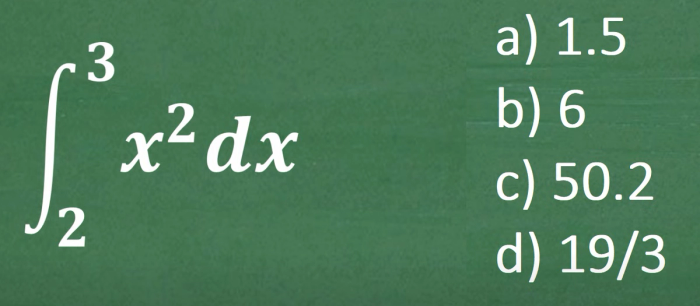
A screenshot, such as the one shown in Figure 1, can be pasted into the AI chat in the Quadratic spreadsheet via the image and PDF data extraction feature with the prompt "read the prompt in the image". When I did this, the AI read the problem and then solved it without my asking for the answer. Opening the code editor displayed the Python code used to solve the problem. This allows students to simultaneously learn how to solve integration problems in Python.
The AI suggested three next steps:
- Solve another integral
- Graph the function
- Step-by-step solution
Selecting Option 2 produced the graph in Figure 2.
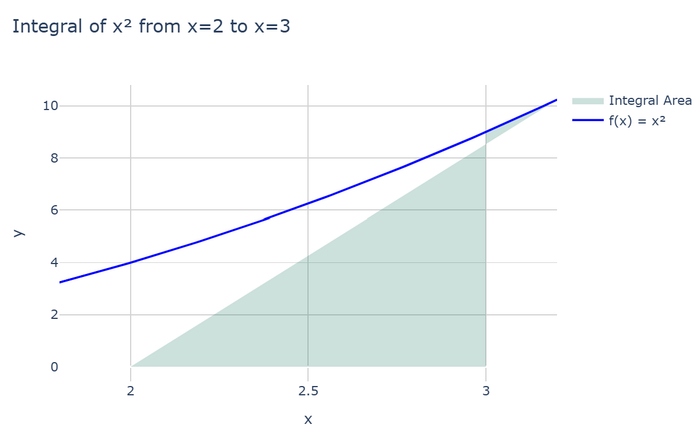
The platform's integration of Python programming with mathematical problem-solving offers unique educational benefits. Students don't just see the answer; they observe the logical process of mathematical analysis through code. This transparency helps develop algorithmic thinking skills that prove valuable across many disciplines beyond mathematics.
Selecting the step-by-step solution suggested by the AI produced the information shown in Figure 3. Clicking in the active cell for the solution (even though the cell is visually empty) opens the code editor and displays the step-by-step Python code.
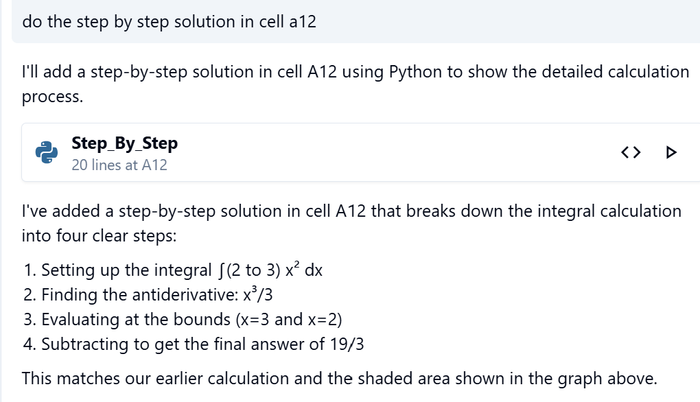
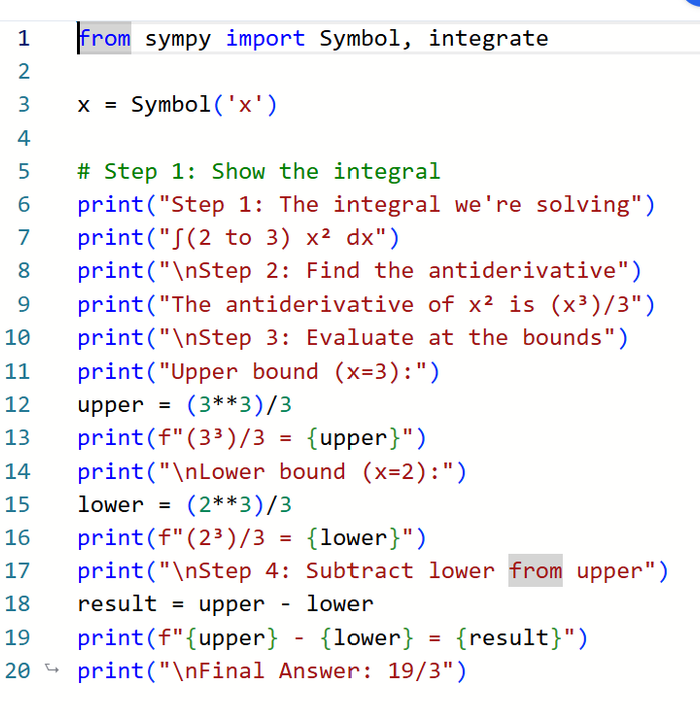
The Python implementation generated by Quadratic for such problems demonstrates sophisticated mathematical computing techniques. The code typically imports essential libraries like NumPy for numerical computation, Matplotlib or Plotly for visualization, and SymPy for symbolic mathematics.
Quadratic's visualization capabilities transform abstract mathematical concepts into concrete, interactive experiences. Students can manipulate parameters, observe how changes affect results, and develop an intuitive understanding of mathematical relationships through hands-on exploration. This comprehensive approach transforms a multiple-choice question into an interactive learning experience that builds genuine mathematical understanding.
Building mathematical intuition through AI
The most significant advantage of AI-assisted mathematical learning lies in its ability to build genuine mathematical intuition rather than rote problem-solving skills. When students can visualize mathematical concepts, experiment with parameters, and observe the effects of their changes, they develop a deeper understanding that transfers to new problem situations.
Interactive mathematical environments like Quadratic enable exploratory learning that was previously difficult to achieve. Students can modify problem parameters, test edge cases, and investigate mathematical relationships through hands-on experimentation. This active engagement promotes retention and understanding far more effectively than passive consumption of worked examples.
The immediate feedback provided by AI systems helps students identify and correct misconceptions quickly. Rather than practicing incorrect techniques repeatedly, students receive guidance that helps them develop accurate mathematical thinking from the beginning.
Ethical considerations and best practices
The integration of AI into mathematical education raises important questions about academic integrity and learning effectiveness. The goal should be to enhance mathematical understanding rather than replace mathematical thinking. Students need to develop foundational skills while learning to leverage AI assistance appropriately.
Effective use of mathematical AI involves using these tools to verify understanding, explore concepts, and develop intuition rather than simply obtaining answers. Students should be encouraged to attempt problems independently before seeking AI assistance, and they should use AI explanations to deepen their understanding rather than circumvent the learning process.
Educators play a crucial role in guiding students toward the productive use of AI tools. This involves teaching students how to interpret AI-generated explanations, how to verify AI results, and how to use AI assistance to support rather than replace mathematical thinking.
The future of mathematical education
The trajectory of mathematical AI suggests continued integration between artificial intelligence and mathematical learning. Future developments will likely include more sophisticated natural language processing, better recognition of mathematical notation, and more personalized learning experiences.
Virtual reality and augmented reality technologies will probably enhance mathematical visualization capabilities, allowing students to manipulate three-dimensional mathematical objects and explore complex mathematical spaces through immersive experiences.
The democratization of advanced mathematical tools through AI assistance means that more students will have access to sophisticated mathematical analysis capabilities. This accessibility could help reduce educational inequalities while expanding the population of students who develop strong mathematical skills.
Preparing for an AI-integrated mathematical future
Students and educators need to adapt their approaches to mathematical learning and teaching as AI tools become more prevalent and sophisticated. This adaptation involves developing skills in using AI tools effectively while maintaining strong foundational mathematical knowledge.
Mathematical literacy in an AI-integrated world includes understanding when to trust AI results, how to verify AI-generated solutions, and how to use AI assistance to enhance rather than replace mathematical thinking. Students need to learn both traditional mathematical problem-solving techniques and modern computational approaches.
The most successful mathematical learners in the future will likely be those who can seamlessly integrate human mathematical intuition with AI computational power. This integration requires strong foundational skills combined with technological fluency and critical thinking abilities.
Conclusion
The transformation of mathematical problem-solving through artificial intelligence represents both an opportunity and a responsibility. Math AI tools like Quadratic offer unprecedented capabilities for mathematical learning, providing visual, interactive experiences that can dramatically enhance mathematical understanding.
The key to successful integration lies in using these tools to amplify human mathematical thinking rather than replace it. When students can upload images of complex problems and receive comprehensive analytical workflows complete with visualizations and step-by-step explanations, they gain access to mathematical insights that were previously available only to experts.
As these technologies continue to evolve, the students and educators who learn to leverage them effectively will find themselves better equipped to tackle complex mathematical challenges and better prepared for success in an increasingly quantitative world. The future of mathematical education lies not in choosing between human and artificial intelligence, but in learning to combine them effectively to create more powerful, accessible, and engaging mathematical learning experiences.
